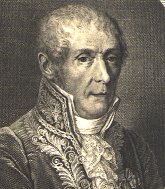|
The Volta-Galvani Debate.
|
|
"The storm which the appearance of the Commentary stirred up in the world of physics, physiology and medicine can only be compared to that which was brewing on the horizon of politics in Europe." (DuBois).
|
|
In 1791 Luigi Galvani (1737-1798), a Bolognese anatomist and physiologist, published a revolutionary work, the Commentarius. In it he revealed an extraordinary discovery: frogs, though decapitated and skinned are able to produce extensive leg movements for a considerable period, if some of their muscles and nerves are connected. Galvani’s experiments were easy to reproduce and the second edition of the book, in 1792, aroused the interest of numerous scientists. Amongst these was Alessandro Volta (1745-1827), a physicist of Pavia University, who started by being very enthusiastic but later became profoundly critical.
|
|
Galvani indeed maintains there is specific electricity in animals, which originates in the brain, is transmitted through the nerves and stored in the muscles. The discharge from there is the motive for the contractions. Galvani’s research programme could therefore be called vitalistic: the movement of the frog’s legs is due to the electricity produced in the brain of the live frog. The model associated with this principle is an analogy between the frog’s legs and the Leyden jar both store electricity which is ready for discharge, producing the famous contractions even in a dead frog. Galvani’s apparatus is that which is traditional in physiology, plus numerous electrical instruments. The quantitative aspect was absent from practically all physiology at that time.
|
|
Volta’s research program, on the other hand, underlined the role of conductors (metals and moist conductors) as the electrical “motive force” in animals. He thus proved contact potential. Volta denied there was specific animal electricity. He interpreted static electricity in the light of his own innovative ideas based on the principle that electric fluid always returns to an initial state of equilibrium, and that it has a tendency (tension) to expand. He supported his ideas by using original instruments, like the condenser electrometer which measures contact potential, and quantification based on the factorisation paradigm, or the product of an extensive amount times an intensive one. For Galvani, frogs produce their own electricity; for Volta they merely reveal the electricity produced by contact between two different types of conductor.
|
|
In the course of the debate Galvani showed frogs moving despite the absence of metal contacts, Volta showed the tension due to bi-metal contact even without a frog present. Galvani tended to oppose the current physiological theories, relying on standard electrostatics. Volta modified standard electrostatics to prove that electricity was not animal-specific – even the non-organic world exhibited the electric fluid’s “tension” to expand, the conductors showing an “electro-motive force”. Galvani founded electro-physiology. Volta, in his attempt to reproduce in the non-organic field those phenomena revealed initially by Galvani (using frogs), first discovered contact potential and then (torpedo fish) invented the bactery.
|
|
The Volta-Galvani debate took place against the socio-historical background of the end of an enlightened despotism and the victorious French Revolution. It is significant that in Paris in 1801 Napoleon awarded Volta a prize for inventing the battery. To understand the research programs of the two scientists, it is as well to put the scientific controversy into its scientific, cultural, and epistemological setting at the end of the eighteenth century. The experiments and apparatus used by Galvani and Volta were enormously successful and changed the development of science, yet their theories found it hard to get established as they were in conflict with the established models of that time.
|
|
|
|


